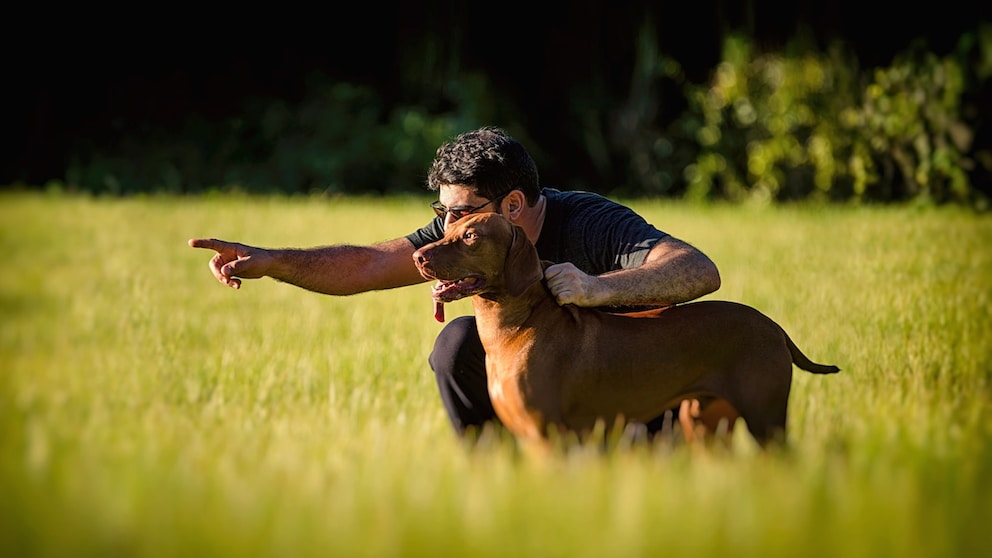February 14, 2025, 4:02 pm | Read time: 4 minutes
Dogs and humans have been working and living together for a long time. Over time, the animals’ sensitivity to human communication has, therefore, become more and more refined. But how well do they really understand our gestures and gaze directions? With the help of an innovative study, we were able to find out how we can best attract a dog’s attention.
Gestures are indispensable in human communication. They not only serve to reinforce our statements but also speed up understanding. Sentences such as: “Look, there” take on more meaning when we point our finger in the direction of the object or nod towards it. We also frequently rely on gestures to communicate with our dogs, but to what extent do the animals truly grasp their meaning? Do they know that we want to show them something, or do they just react to the movement? A recent study has demonstrated the most effective ways to attract dogs’ attention.
How Dogs React to Our Movements
Christoph Voelter from the University of Veterinary Medicine, Vienna, and his colleagues have investigated whether dogs can detect our intentions or simply follow our movements. The researchers employed mobile eye-tracking technology, which included glasses with an integrated camera. The dogs had been trained on the equipment prior to the study and could exit the experiments at any time if they wished.
This allowed the visual reactions of dogs to human signals to be analyzed in real time for the first time. The results show surprising differences between purely directional gestures and those that are truly referential – i.e., directed towards a specific object. This is because previous studies suggest that dogs are more likely to respond to ostensive signals – such as eye contact or direct speech – and thus follow human gestures.
The researchers examined 20 domestic dogs in a standardized test setup with five different conditions:
- Pointing (with arm outstretched towards an object)
- Pointing + gaze direction (combined pointing and looking at the object)
- Gaze direction only (repeatedly looking at the object)
- Apparent throw (a movement that merely suggests a direction but is not referential)
- Control condition (no gesture)
In each condition, it was observed whether the dog followed the human’s signal with its gaze and then selected the correct object. The researchers analyzed both the eye movements during the signals and the dogs’ final decisions.
Finger Pointing or Gaze? Which is Best to Attract Dogs’ Attention
The results show clear differences in the way dogs respond to different gestures and how we can best get their attention:
- The combination of pointing and gaze direction was most effective. Dogs followed this signal most reliably with their gaze and chose the correct object more often than in other conditions.
- Pointing alone was also effective but not as reliable as the combination of pointing and gaze direction.
- Gaze direction only was not sufficient to direct the dogs’ attention specifically to the object.
- The sham throw resulted in the dogs looking in the right direction but not necessarily selecting the correct object.
- In the control condition (no gesture), the dogs chose the correct object only at random.
It was particularly noteworthy that in the condition combining pointing and gaze direction, the dogs not only looked more frequently in the correct direction but also alternated their gaze between the human’s face, hand, and the object, suggesting they truly understood the gesture as referential.
How to Most Effectively Attract Dogs’ Attention
This study provides new evidence that dogs not only follow directional gestures but actually have some understanding of the meaning of our communication. This means that they don’t just follow a movement but can actively process information about a particular object.
For dog owners and trainers, this leads to an important insight: clear combinations of pointing and eye contact help dogs to better understand what they should focus on and what can be used to attract their attention. This insight could be especially beneficial during training sessions or daily activities, such as retrieving items or searching for objects.
In addition, the study shows that mobile eye-tracking technology is a promising method for investigating dogs’ understanding of human signals in more detail, potentially also revealing differences between different dog breeds or training backgrounds.

“If You Blink, I’ll Blink Back!” How Dogs React to Other Dogs

How Smart Are Cats Really?

Chimpanzees communicate with sign language as fast as humans speak
Further Research Needed
While the mobile eye-tracking method allows for realistic measurements and yields more accurate results than previous methods, additional research is necessary. This is because only 20 dogs took part in the study. However, larger and more diverse groups could confirm the results.
It would also be interesting to compare animals from shelters and with different training backgrounds. This is because individual experience and socialization could have a significant influence on dogs.1

